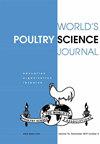双氧水雾化消毒与甲醛熏蒸消毒对孵化前种蛋孵化率和肉鸡生产性能的影响
IF 3.5
3区 农林科学
Q1 AGRICULTURE, DAIRY & ANIMAL SCIENCE
引用次数: 2
摘要
作为质量保证体系的一部分,孵化蛋消毒是商业孵化场的标准程序。甲醛在过去和现在都被广泛使用,但对人体的危害很大。在初步研究中,成功地测试了双氧水喷雾的应用,并选择在田间条件下比较其效果和对孵化率的影响,以及在育肥期间和屠宰时对甲醛的影响。试验设置了两个种鸡群的孵化蛋,在4个不同的鸡龄(38、39、56、57周)分别分成3组(H2O2、甲醛和未消毒对照组)平行运行。在孵化场没有发现显著差异,而在饲养期间,试验1和试验2中所有未消毒组和一个甲醛处理组的7天死亡率和总死亡率较高,因此需要进行抗生素治疗。在屠宰时,所有组的结果都具有可比性。试验3和4在所有组之间没有显着差异,从而得出结论,孵化蛋消毒降低了感染相关损失的风险。同时,甲醛熏蒸和过氧化氢喷雾在各阶段的效果相似。本文章由计算机程序翻译,如有差异,请以英文原文为准。
Impact on Hatchability and Broiler Performance after Use of Hydrogen Peroxide Nebulization versus Formaldehyde Fumigation as Pre-Incubation Hatching Egg Disinfectants in Field Trial
Hatching egg disinfection, as part of the quality assurance system, is a standard procedure in commercial hatcheries. Formaldehyde was and is broadly used but bears high risks for the personnel. In preliminary studies, the spray application of hydrogen peroxide was successfully tested and was chosen to compare its efficacy and impact on hatchability, as well as performance during fattening, and at slaughter, to formaldehyde under field conditions. The trial was set up with hatching eggs from two breeder flocks, running parallelly in three groups (H2O2, formaldehyde and non-disinfected control) at four different flock ages (at 38, 39, 56, 57 weeks). No significant differences were noticed in the hatchery, whereas in the rearing period higher 7-day- and total mortalities occurred during trials 1 and 2 in all non-disinfected groups and one formaldehyde-treated group, making an antibiotic treatment necessary. At slaughter, the findings in all groups were comparable. Trials 3 and 4 passed without significant differences between all groups, leading to the conclusion that hatching egg disinfection lowers the risk of infection-related losses. Meanwhile, formaldehyde fumigation and the spraying of hydrogen peroxide produced similar results in all stages.
求助全文
通过发布文献求助,成功后即可免费获取论文全文。
去求助
来源期刊

World's Poultry Science Journal
农林科学-奶制品与动物科学
CiteScore
6.10
自引率
7.40%
发文量
55
审稿时长
12-24 weeks
期刊介绍:
World''s Poultry Science Journal is the official publication of the World’s Poultry Science Association. The journal provides authoritative reviews in poultry science and an international forum for the exchange and dissemination of information including research, education and industry organisation. Each issue includes poultry industry-related news, regional reports on global developments in poultry, reports from specialist scientific working groups, book reviews, association news and a calendar of forthcoming events. Coverage includes breeding, nutrition, welfare, husbandry, production systems, processing, product development, physiology, egg and meat quality, industry structure, economics and education. The journal is of interest to academics, researchers, students, extension workers and commercial poultry producers.
 求助内容:
求助内容: 应助结果提醒方式:
应助结果提醒方式:


